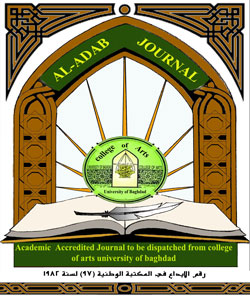Chronological construction and its implications in the novel (Jurists of Darkness)
DOI:
https://doi.org/10.31973/aj.v0i112.1456Keywords:
/Abstract
This research is concerned with the setting of time in Saleem Barakat's novel The Scientists of Darkness . The writer , who is a famous Syrian poet , concentrates on the setting of time in his novel in which time plays a great role in it. The writer has dealt with "time" as if he is dealing with "place" which has a physical identity, giving it characteristic features of a matter in many sketches. He used the temporal techniques to establish a powerful basis of time depending on the temporal elements of flashback (analepsis) and flashforward(prolepsis). Time duration which consists of deletion, summarizing, scenery and in addition to the content of time of repeated incident and repeated manner.
The researcher follows an analytical procedure keeping away from using only statistical samples for each case. And he kept the analysis away from the aesthetic spiritual aspect of literature and its semantic connotation and symbolic aspect of ideas and meanings. The researcher penetrated deeply to reach to a conclusion that will justify the purpose of the novelist behind using and repeating all these features by using a list of references at the end of the study.
Downloads
References
~ انتصار الزمن، محمد عبدالحسين الدعمي، سلسلة كتب شهرية تصدر عن دار آفاق عربية للصحافة والنشر، 1985م، (د.ط).
~ إيقاع الزمن في الرواية العربية، أحمد حمد النعيمي، المؤسسة العربية للدراسات والنشر، الطبعة الأولى، 2004.
~ بناء الرواية ، دراسة مقانة في ثلاثية نجيب محفوظ، سيزا قاسم، مطابع الهيئة المصرية العامة للكتاب.
~ بناء الزمن في الرواية المعاصرة، د. مراد عبدالرحمن مبروك، الهيئة المصرية العامة للكتاب، 1988م، (د.ط).
~ بنية النص السردي – من منظور النقد الأدبي، حميد الحمداني، المركز الثقافي العربي، الطبعة الأولى، 1991م.
~ تحليل الخطاب الأدبي على ضوء المناهج النقدية الحداثية دراسة في نقد النقد، محمد عزّام، منشورات اتحاد كتاب العرب، دمشق، 2003.
~ تحليل الخطاب الروائي (الزمن- السرد- التبئير)، سعيد يقطين، المركز الثقافي العربي للطباعة والنشر والتوزيع، ط3، 1997م: 89.
~ التعبيرية في الشعر والقصة والمسرح، عبدالغفار مكاوي، الهيئة المصرية العامة، للتأليف والنشر، القاهرة، 1971م، (د.ط).
~ خطاب الحكاية، بحث في المنهج، جيرار جنيت، ترجمة: محمد معتصم، عبد الجليل الأزدي، عمر الحلي، منشورات الاختلاف.
~ الزمن في الأدب، هانز ميرهوف، ترجمة: أسعد رزوق، مراجعة: العوضي الوكيل، سجل العرب، القاهرة، 1972م.
~ الزمن في الرواية العربية، مها حسن قصراوي، دار فارس للدراسات والنشر، ط1، 2004م.
~ الزمن والرواية، ترجمة: بكر عباس، أ.أ.مندلاو، مراجعة : إحسان عباس، دار صادر للطباعة والنشر، بيروت، الطبعة الأولى، 1997م.
~ الشعرية ، تزفيطان تودورف، ترجمة: شكري مبخوت ورجاء بن سلامة، دار توبقال للنشر، الدار البيضاء، المغرب.
~ فقهاء الظلام، سليم بركات، دار الكرمل، الطبعة الثانية، (د.ت).
~ في نظرية الرواية، بحث في تقنيات السرد، عبد الملك مرتاض، عالم المعرفة، التسلس 240، 1998م، (د.ط).
~ لسان العرب، ابن منظور، دار صادر، بيروت، (د.ط)، (د.ت)، الجزء الخامس.
~ مدخل إلى نظرية القصة –تحليلاً وتطبيقاً- سمير المرزوقي، جميل شاكر، دار الشؤون الثقافية العامة، بغداد، 1986م.
~ معجم السرديات، مجموعة من المؤلفين، إشراف: محمد القاضي، اشتركت في نشرها مجموعة كبيرة من دور النشر، الطبعة الأولى، 2010م.
~ النقد التطبيقي التحليلي، د. عدنان خالد عبدالله، دار الشؤون الثقافية العامة، وزارة الثقافة والإعلام، الطبعة الأولى، بغداد، 1986م.
~ الوجيز في دراسة القصص، لين أولتنبيرد وليزلي لويس، ترجمة: عبدالجبار المطلبي، منشورات دائرة الشؤون الثقافية والنشر، بغداد، 1983، (د.ط).
~ Russell, Bertrand, Human, knowledge. N. Y. Simon & Schuster, 1984.
مواقع الأنترنيت:
~ الرواية والزمن، ماريو بارجاس يوسا، ترجمة: بسمة محمد عبدالرحمن، مقطع منقول عن كتاب (الكاتب وواقعه) الصادر عن المشروع القومي للترجمة بمصر،2012. http//ahmed-elhadary.blogspot.com
~ الفضــاء والـــزمــن في الرواية العربية، د. حورية الظل، موقع m.almothaqaf.com/index.php/qadaya 2009/53174.html.
~ لقاء مع سليم بركات، حاوره: عدنان حسين أحمد، لـ جريدة ( الزمان ). الموقع الألكتروني www.ahewar.ovg/debat/ show-art-asp?aid=14671.
~ المفاتيح: تحليل لبعض روايات سليم بركات، د. عباس توفيق، الموقع الألكتروني www.nashiri.net/criques-and- reviews/critiques- andanalysas/5372-2013-03-18-12-50-31.html
Downloads
Published
Issue
Section
License
Copyright and Licensing:
For all articles published in Al-Adab journal, copyright is retained by the authors. Articles are licensed under an open access Creative Commons CC BY 4.0 license, meaning that anyone may download and read the paper for free. In addition, the article may be reused and quoted provided that the original published version is cited. These conditions allow for maximum use and exposure of the work.
Reproducing Published Material from other Publishers: It is absolutely essential that authors obtain permission to reproduce any published material (figures, schemes, tables or any extract of a text) which does not fall into the public domain, or for which they do not hold the copyright. Permission should be requested by the authors from the copyrightholder (usually the Publisher, please refer to the imprint of the individual publications to identify the copyrightholder).
Permission is required for: Your own works published by other Publishers and for which you did not retain copyright.
Substantial extracts from anyones' works or a series of works.
Use of Tables, Graphs, Charts, Schemes and Artworks if they are unaltered or slightly modified.
Photographs for which you do not hold copyright.
Permission is not required for: Reconstruction of your own table with data already published elsewhere. Please notice that in this case you must cite the source of the data in the form of either "Data from..." or "Adapted from...".
Reasonably short quotes are considered fair use and therefore do not require permission.
Graphs, Charts, Schemes and Artworks that are completely redrawn by the authors and significantly changed beyond recognition do not require permission.
Obtaining Permission
In order to avoid unnecessary delays in the publication process, you should start obtaining permissions as early as possible. If in any doubt about the copyright, apply for permission. Al-Adab Journal cannot publish material from other publications without permission.
The copyright holder may give you instructions on the form of acknowledgement to be followed; otherwise follow the style: "Reproduced with permission from [author], [book/journal title]; published by [publisher], [year].' at the end of the caption of the Table, Figure or Scheme.












